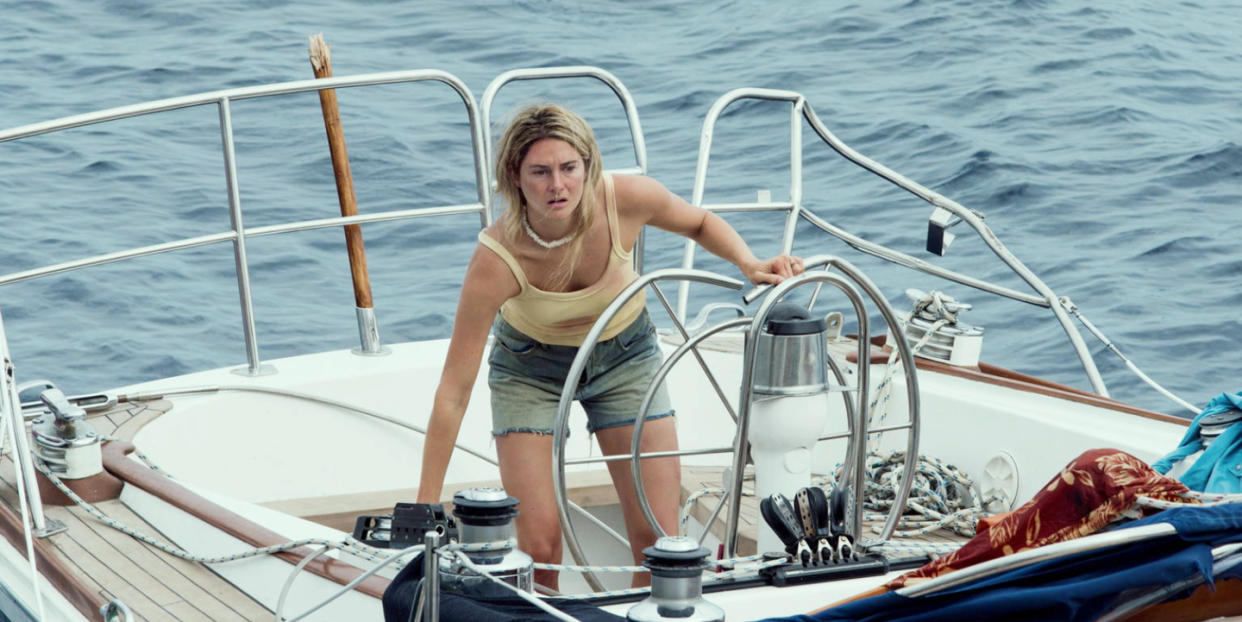The True Story of ‘Adrift,’ Shailene Woodley’s Sailing Disaster Movie

This post contains spoilers for the movie Adrift.
If you noticed that the 2018 movie Adrift suddenly appeared on your Netflix home page this weekend, welcome! The movie, which is based on a true story, stars Shailene Woodley and Sam Claflin as Tami Oldham Ashcraft and Richard Sharp, two sailors who embarked on a voyage from Tahiti to San Diego in 1983 and ran smack into Hurricane Raymond. The movie depicts the events leading up to their trip as well as the storm and its aftermath, but the movie doesn’t tell quite the whole story. Before you read on, though, know that the real story will spoil the movie, so proceed at your own risk.
In September 1983, 23-year-old Ashcraft and her fiancé, Sharp, took a job sailing the yacht Hazana to San Diego, a journey of more than 4,000 miles. Less than three weeks into the trip, Ashcraft and Sharp encountered Hurricane Raymond, which produced 40-foot waves and 140-mph winds. On October 12, Sharp told Ashcraft to go below deck to take a break, but the boat capsized and Ashcraft was knocked unconscious. When she awoke a day later, Sharp was gone and his safety line was dangling over the side of the boat.
At that point, Ashcraft had to make any repairs she could and attempt to sail the boat to land. She pumped water out of the cabin, rigged up a sail using an extra jib, and began navigating manually, using only a sextant (which is a navigational device people use while sailing) and a watch. Determining that San Diego was too far away, she aimed for Hawaii—still a journey of 1,500 miles. She completed the trip in 41 days and survived by eating canned food and peanut butter.
Video: Shailene Woodley says ‘very scary’ illness almost ended her career
“The hardest part was dealing with Richard being gone,” she told the Chicago Tribune in 2003. “But actually, while I was in the survival mode, the grief was fairly low. It wasn’t as intense as when I got to shore and the survival was over, and I could see people together and everything kept reminding me of him.”
Obviously, the movie version of Sharp survives well past the arrival of the hurricane, but only sort of. In Red Sky in Mourning, her memoir about the ordeal, Ashcraft says that she felt as though some sort of voice was guiding her. While she described this voice in 2003 as her own “inner spirit,” the movie interprets the voice as Richard and ultimately reveals that he was swept off the boat during the hurricane. What Ashcraft “sees” after the wreck is just a manifestation of his spirit, and all the tasks she completes to reach Hawaii are things she achieves by herself.

Whether this trick is successful or not is up to the viewer, but for her part, the real Ashcraft seems to be fine with it. In an interview with Cosmopolitan, Sam said she “helped the writers initially with the story.” She also visited the set during shooting, and according to Sam, she gave him her blessing for his portrayal of Sharp. “We’re telling her story, and she seemed to be championing it,” he said.

Despite having undergone a horrific ordeal on the open ocean, Ashcraft still sails today. “I just love it,” she’s said. “I’m passionate about it. I kind of parallel [the hurricane] to being in a car accident. You get back in the car or, like they say, back on the horse.”
She spoke with the Royal National Lifeboat Institution in 2019 about how people can be safe while sailing and what to do if they ever find themselves in trouble at sea. “The first [rule] is: Don’t mess with Mother Nature,” she says. “Study the weather because Mother Nature is much bigger than we are. That’s one of the most important things I can say.”
Ashcraft even encouraged using modern devices. “With today’s technology, you can get up-to-date weather reports and marine weather faxes,” she said. “In 1983, we could only get the weather every three hours. Also, now electronics are so much better and waterproof.”
But she did emphasize that her sextant was what saved her life. “…I tell you, that sextant saved my life. Even if it’s a plastic sextant—I always say that if you’re going to do ocean crossings, make sure there’s a sextant onboard with the relevant tables. Because in the end, if all the batteries go, you have that to fall back on. And that is what saved my life.”
You Might Also Like